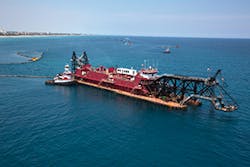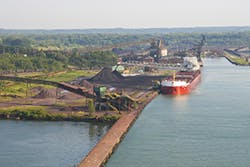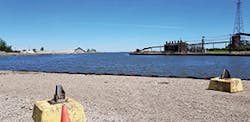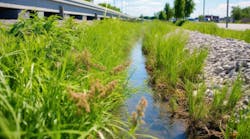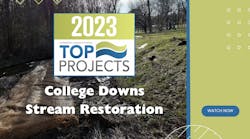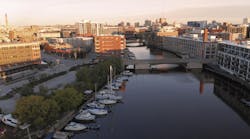As the restless spirit overtook American colonists to push west for land, the harbors of the Great Lakes were a welcoming landscape. Here lay the potential to expand their dreams of a flourishing commerce—to export the bounty of prosperous farms and products of fledgling industry. This possibility was enhanced with the extensive canal and rail system linking other regions to the Great Lakes, making it far easier and faster to move supplies and products by water than by overland transport.
Today, maintaining these commercial “marine highways” is a nonstop effort for the many Great Lakes port authorities who have oversight of cargo operations.
“At one time, when we were one of the first ports in Ohio, and before the St. Lawrence Seaway, Toledo was a huge transportation hub,” says Joe Cappel, vice president of business development for the Toledo-Lucas County Port Authority.
Between the time Ohio became a state in 1812 and the turn of the century, Cappel says, the city’s success generated grand visions. “Everyone thought we would be a leading metropolitan area—bigger than Chicago. While that didn’t happen, Toledo is still a premier site for incoming and outgoing shipping trade.
“Our port is the whole Toledo harbor, but it’s not all in one place. We have seven miles of riverfront, with 18 terminals, and we are what’s called a landlord port,” which, he explains, is a quasi-governmental organization.
“We own some of the land and are governed by both state legislature authorities and by a board of directors, with six of those being appointed by county commissioners and six by the City of Toledo.”
He adds that there is public oversight from the board and by the State of Ohio, but “We’re really not beholden to any official or administration as we operate independently. Our terminals are operated by different companies; some are private, and as the port authority, we work with those companies to assist them in growing their businesses and generating additional opportunities for cargo handling and job creation.”
But regardless of ownership, vessel size, or commodity, there is one ever-present factor on the minds of everyone affiliated with Toledo’s shipping activity: having a clear maritime channel. And equally crucial to that end for this operation that sees 500 to 800 vessels transporting 9 million to 12 million short tons of cargo every year is dredging, the very key to their success.
Without constant annual dredging of Toledo’s shipping lanes, Cappel says, their traffic of 700- to 1,000-foot-long ships cannot navigate the channels.
“This is essential to our survival. The dredging is the responsibility of the US Army Corps of Engineers [USACE], who maintain our shipping lanes just as the Department of Transportation takes care of highways. These channels are the roadways of the water and require essential maintenance to ensure their economic viability.
“Why would we take a chance [by not dredging] with the world’s largest freshwater transport system? We must ensure the continued economy of this vital shipping trade, because port activities support our regional economy and create jobs. Waterborne transportation is the most efficient transportation mode and has the least impact on the environment in terms of air emissions.”
In fact, Cappel says that while the Great Lakes have competition from the US East Coast and Gulf ports, “It’s faster to get our cargo out to the Atlantic and to Europe through the Great Lakes compared to sending by truck or rail to those other ports who cross the Atlantic to the same destination. Through the Great Lakes, we can do in a week what would take much longer, and with a smaller carbon footprint and in a more streamlined service.”
But the early expansion of Toledo that launched its prosperity of today did not come without a cost. Cappel describes how the draining of the region’s Great Black Swamp more than 150 years ago in efforts to tame the land for agriculture is the single most important legacy factor contributing to erosion, Lake Erie algae blooms, and staggering waterway nutrient contamination a century later. He says the net effect today “requires dredging Toledo by the USACE of 800,000 to 1.1 million cubic yards of silt and sediment—performed by contractors hired by the Corps—every year.”
However, when it comes to Toledo’s dredge protocol, things are in the process of change. Cappel says that new legislation recently passed by the State of Ohio will ban any open-lake disposal of dredge in Lake Erie, effective in 2020. This presents a big challenge as Toledo accounts for “more than 50% of all Lake Erie dredge” and must find either another place to put it or devise suitable repurposing of its annual dredged material.
New Strategies, New Tactics
David Emerman, the general counsel and dredge program administrator for the Ohio Lake Erie Commission, an affiliate agency of the Ohio EPA, elaborates on how the policy affects the dredge activity of coastal Lake Erie’s maritime industry.
“In Ohio, we have eight federally managed commercial navigational harbors along Lake Erie, which accommodate the annual transport of an estimated $25 billion worth of commodities and which support 130,000 jobs. Clearly, maintaining Ohio’s harbors is crucial to our regional and national economy.”
Yet given that Lake Erie is the shallowest of the Great Lakes, its harbors also have the largest dredging needs.
“The traditional practice was to dump the dredged material into the lake after it had been removed by the Corps, but with new legislation, by 2020 the Corps will no longer be allowed to perform open-lake dumping. This means we have to find a home for millions of cubic yards of sediment.”
There’s a backstory to this scenario to curtail the open-lake dumping; the ban was initiated to address the ongoing battle with nutrients that has plagued Lake Erie for decades. Despite numerous BMPs, in the face of climate change, rising water level, and its notoriously shallow basin, Lake Erie has nonetheless experienced an increase of algae bloom occurrences. The severity has increased to the point of threatening public health in 2014, when Toledo residents’ drinking water supply was affected.
While keeping the nutrient-laden sediments out of Lake Erie is a primary goal, Emerman says, the stakeholders have long been considering various alternative uses for the dredge material.
“Keep in mind that dredge sediment is very different from harbor to harbor, so a one-size-fits-all solution doesn’t work here,” he explains.
“Toledo, for example, has runoff from millions of acres of farmland, runoff that feeds the Maumee River basin and then conveys to Lake Erie. The dredge material from this area is thick, mucky silt and clay in its composition. Contrast this to the more eastern harbors—Cleveland and Lake County to the east, for example—where the sediments are fine sand and aggregate. These differing compositions dictate very different applications for their reuse. So what might be bad for the lake coming out of Toledo might be very good for farm fields,” says Emerman.
Lake Erie’s Conneaut Port
A Recycling Plan That Works
During a workshop comprising diverse stakeholders and designed to brainstorm activities that would support the outcome of repurposing dredge material no longer destined for the lake, the participants identified three major areas as suitable options to explore, says Emerman.
“We wanted to find areas where dredged material could add value to the community. By encouraging those communities to explore opportunities to convert dredge, which has often been designated as waste or unusable, into a commodity unto itself, they can enhance their own region,” he says.
He cites three primary repurposing uses.
“The first is to take the dredge, treat and dry it, and turn it into a topsoil—for example, bulk soil for nursery usage. Another opportunity is to take suitable dredge and use it to build wetland habitat,” which he says is very important to restoring shorelines. “This has a dual benefit: improving water quality and encouraging wildlife to the area. These wetlands support native plants. Wetlands slow water down, meaning reduced water velocity, and attracting fish, birds, and other wildlife to the area gives the community a valuable new asset.”
He says the wetlands can be built within the lake or near the confined disposal facilities (CDFs), near the harbors, where dredge is placed for dewatering.
The third opportunity Emerman describes is “to take the dredge to the farmfields.”
He notes, “This is an ideal solution for the northwest Ohio materials like Toledo’s, which are known to be nutrient rich, as these can add economic value to the soil.”
For Joe Cappel, the cost of compliance for the new scenario of 2020 presents some unknowns that could potentially affect his operations.
“The harbor maintenance tax is the revenue that funds the Corps’ operation upon which we depend. While this money theoretically goes to the Fed to support national dredging operations, only a portion actually goes into harbor maintenance, as funds can and have been used for other federal projects. So now, if we have all this material that can’t easily be disposed by dumping in mid-lake, there are questions about finding funds to pay for the alternative uses. There are programs and grants, but this is still more than a year away, and how it will all work is an unknown we are working through. But, like any new program, we have to really think strategically to turn what could be a problem into good opportunities—it’s a challenge we will meet.”
Maintaining a Leadership Role
In the heyday of US steel production, the traffic of ore boats that plied the Great Lakes was at an all-time high. The boats brought raw materials from the northern reaches of the US and Canada and offloaded them to Lake Erie and Lake Michigan ports; the materials were then conveyed by rail to blast furnaces, destined for global suppliers of industrial steel and the manufacture of consumer goods such as cars and refrigerators.
Recalling how the steel industry “dominated the ports,” Conneaut city manager Jim Hockaday concedes that steel production is not what it once was; however, the far eastern Lake Erie port continues to be very active.
“We’re rated as the 82nd-largest port, which is out of a total of about 200 US ports. Today we handle about 5 million gross tons a year, and, being right on the border of Pennsylvania, we are close to both Ohio and Pennsylvania manufacturing. As the third-strongest port in Ohio, we get our share of Corps money for harbor maintenance, most of which goes to dredging.”
However, he explains that unlike its northwest port neighbors, Conneaut has fewer issues to contend with.
“Depth is a big issue, and as Lake Erie is the shallowest of all the Great Lakes, it still accounts for more than half of the total Great Lakes’ dredge activity. But to our benefit, up here on the northeast coast we have a draft of 65 feet, which is nearly three times that of Toledo, whose draft is only 25 feet.
“Plus, as most ports are at the mouth of a river or tributary, and the upland area drains into that, often bringing problems, we have the advantage that our tributary, the Conneaut Creek, although it is really a river, is in 100% full attainment for water quality. In Toledo, they have the effect of draining nutrient-rich soils, but here, we are on slate. The Conneaut Creek has never really been contaminated, and our dredged silt is mostly sandy, gravelly composite taken from the port.”
Hockaday observes that while Conneaut does not experience the same level of algae blooms as Toledo, and its treatment plant is the farthest east plant serving Ohio, “we get our drinking water from the lake and are not immune—we have also experienced algal issues in our raw drinking water intake. So the entire lake is everyone’s concern.”
He continues, “This is not just a western basin problem; everyone has a vested interest in clean and clear water. While some ports [have historic contaminated sediments], we are clean, but that doesn’t make us less concerned about the entire health of the lake as a whole.”
As far as dredging, he says, “Our deepwater terminal is privately owned, and we dredge every two years, generating about 150,000 cubic yards of material, which makes us a small player, only about 5 or 6% of total Lake Erie dredge, when compared to the other ports.”
In June of 2020 when the legislation goes into effect and harbors need to have alternative repurposing schemes in place, says Hockaday, “We want something that transactionally makes money, and we don’t want to lose ports and revenue.” And he has thoughts on how the cessation of open-lake dumping could be turned to an advantage in a variety of markets.
“For us here at Conneaut, we have a massive infrastructure, one of the biggest bulk handling facilities on the Great Lakes, that could take all bulk and handle it easily. It’s an underutilized infrastructure, and we have three square miles of property, clean waterways, no hazards, and we can hook to a railroad.
“So we could offer a solution to help handle this material. The dredge can be repurposed as sand in building material, for cement products, and for soil stabilization. In Pittsburgh, it could be used as a good bioretention material. And in terms of agricultural use, returning dredge and the natural organics to that use might be better and even cheaper than using fertilizer.”
Finally, Hockaday says, it’s a good thing that one size does not fit all because there is a “willingness to handle this locally.”
“We have to decide how to use our assets and see this as an opportunity. For example, we can collaborate with a compost facility and create soil enhancement. We can’t rely on some future magic resurgence in coal to bring us needed revenue. But I explain to people that our city spends $50,000 on compost and $100,000 on wastewater biosolids. If I can use this [dredge] material and cut that in half, in small towns like this that’s real money.”
He also says that it is crucial to start figuring this out by “involving a constellation of intellectual capital.” He cites collaboration with universities, agricultural extension services, water authorities, and others as essential. “We need to know what we are doing is correct [because] the stakes are high.”
Conneaut Port
From “Waste” to “Clean”
While repurposing dredge isn’t quite a turning-lead-into-gold endeavor, innovators are intrigued at the potential opportunities but also cautious about the path to profitability. However, before picking up a shovel of dredge to create the latest engineered soil or unique permeable paver, says Chad Ferguson, environmental scientist with Ohio EPA, any dredge material needs to first be designated “a safe and clean product for beneficial use.”
“From a regulatory standpoint, dredge has been considered a waste. You collected it and then had to dispose of it,” says Ferguson.
While beneficial use is not a new idea, Ferguson notes that interest has increased significantly now that the 2020 ban on open-lake disposal is going into effect. To ensure that dredge material is safe for beneficial use, Ferguson explains, a harbor sediment profiling project was performed to assess contaminants and identify risk-based standards that dredge could be compared to. Those standards are considered protective enough of public health and the environment to allow beneficial use of dredge in residential soil settings.
Ferguson adds that data have been collected from Ohio EPA, the USACE, the National Oceanic and Atmospheric Administration, and US EPA for all eight federal harbors. For all harbors, four classes of contaminants were analyzed: heavy metals, polycyclic aromatic hydrocarbons (PAHs), polychlorinated biphenyls (PCBs), and pesticides, with data evaluated from multiple years of sampling efforts.
Ferguson indicates that dredge from the majority of Ohio’s federal harbors is clean enough for beneficial use in residential soil settings.
“While rules for this process are in development as we speak, the expectation is that dredge that has been characterized as clean enough for residential soil is clean enough to not be considered a waste and will not need a permit for beneficial use. In other words, we don’t need to keep track of it—it’s that clean,” he says.
“In some cases, though, more contaminants may be present. This doesn’t mean that the material can’t be beneficially used, but then a processor would need to request a general permit, which may include certain restrictions on how and where the material may be used and require monitoring and recordkeeping.
“If it’s more contaminated still, an individual permit may be required, which would likely impose further restrictions with additional increased monitoring and recordkeeping over a general permit,” he explains.
Last on the list would be dredge that is compromised to the point that no beneficial use can be made. This relegates the material to a confined disposal facility where it is dewatered and eventually disposed of, unless contaminants can be remediated and effectively reduced or removed from the material.
However, the cleanest of the dredge, which is currently the status for much of Lake Erie’s dredge, can be “free-released,” and Ferguson is enthused at the potential opportunities for its reuse.
“Sediments that are dredged from navigational channels and harbors originated from disturbed soils and erodible sediments in the upper watersheds, very often from farmfields. Returning clean sediments to farmfields, especially as they are shown to have agronomic value, just makes sense.”
But what really excites Ferguson is coastal wetlands restoration. “Ohio has lost 90% of its coastal wetlands. Especially given that lake levels are at historically high levels, beneficial use of clean, dredged sediments may play a central role in large-scale coastal wetlands restoration along Lake Erie, which not only reduces coastal erosion by buffering wave action but creates valuable habitat for fish and wildlife. Thousands of acres of restored wetlands may even help lower phosphorus levels over time in the lake, too.”
New Attitude for New Uses
Now celebrating 70 years in the family business, Cleveland-based Kurtz Bros. Inc. “began in the landscape supply business in the 1940s and over the decades evolved into a waste-to-resource company,” says the company’s business development director, Jason Ziss.
“I like to say that we’re experts in beneficial reuse. If it’s discarded, we look for a way to repurpose it. Right now, we are the largest organic recycler in Ohio,” taking yard, municipal, and food waste to either one of the company’s many compost facilities or to its anaerobic digester, converting biomass waste into energy.
“Plus, we also manage construction demolition debris, sediments, and industrial waste, and with decades of experience in horticulture and waste management, we can extract usable material to get the best value for materials that are thrown away,” he says. “If it can be reused, we can save your business or municipality time and money.”
Kurtz Bros. is currently in its fourth year of operation with the Port of Cleveland, and Ziss reports the company has “gone through the learning curves of recycling dredge material and [is] now set to operate on the third iteration of the site layout.”
He explains the collaboration. “We work for the Port of Cleveland through a public-private partnership, and in helping the State of Ohio keep sediment out of Lake Erie, we’re working to find uses for the most valuable material from the 250,000 cubic yards of dredge material taken out of the harbor and Cuyahoga River region each year.”
Ziss says the company now recycles about half of the material dredged annually. “We break down and separate out the different components of the sediment. Sediment from this area consists of silts, clays, and sands, and each has its own natural market value.
“The material is hydraulically pumped into a confined disposal facility, but that is actually a misnomer as CDFs are usually considered a waste storage, but we are now using them as recycling centers.
“First, we let the material dry, then separate it out. Drying can take months, or it can take years. Then after it’s dry and separated, we identify the cleanest materials for reuse; the dirtier materials are slated for remediation or onsite disposal.”
Ziss says sand is a welcome addition for construction application, and “if you process them right, the clays and silts can be used for other construction or horticulture applications. In construction, for example, we can repurpose the material to be used for structural fill or for pipe bedding, and then with some treatment, the horticultural market can also benefit. We can create engineered soil for landscaping uses, landfill capping, and there are many erosion and sediment control uses as well,” he affirms.
Ziss adds that while the company’s repurposing success with the Port of Cleveland is largely due to the type of recovered materials, ingenuity and attitude are equally important.
“We need to take a new perspective on how to reuse what has been traditionally considered waste materials, and we can do this by not looking at what has been done, but what can be done, by taking a more proactive and more sustainable view.”
Ziss is optimistic about the State of Ohio’s options. “We’re in a good position to create sustainable solutions, and we’re investigating what we are doing in Cleveland and throughout the state to help benefit Lake Erie and the rest of the Great Lakes. While the biggest issues are in Ohio, other areas on the Great Lakes such as Chicago and Saginaw are running out of dredge disposal space. The successful waste-to-resource concepts we’ve done here are dedicated, long-term 20- to 30-year solutions, and we believe these can benefit other regions, so it definitely merits exploring those opportunities.”
Conneaut Port
From Interlake to International
With cargo valued at $3.5 billion and more than 20,000 jobs dependent on maritime commerce, the Port of Cleveland is a crucial link to both local and national economies, says Nicholas LaPointe, director of planning and capital development for the Cleveland-Cuyahoga County Port Authority.
“The Port of Cleveland is the first major US port of call inside the St. Lawrence Seaway system on the Great Lakes. Our primary international trading partner is northern and central Europe. We are also a major inland Great Lakes port, where bulk commodities move between ports within the Great Lakes. When we talk about Great Lake bulk commodities, we are referring to the raw materials for manufacture of goods in the US and abroad, including salt, iron ore, and aggregates.”
Being connected to the St. Lawrence Seaway for transatlantic shipping, indicates LaPointe, it is actually faster to ship a container from Antwerp to Cleveland via a direct marine transport than it is to ship the same container through an East Coast port and then by rail to Ohio. In addition, it’s more environmentally friendly, results in less wear and tear on highways, reduces stress on East Coast infrastructure, and involves less handling. For this reason, the Port of Cleveland offers a regularly scheduled container service between Antwerp and Cleveland that presently operates twice a month during the shipping season.
He explains that the port authority, founded by the state in 1968, is a local government body established by the state that works with all the users and the stakeholders of the harbor and with local, state, and federal governments. The Port of Cleveland also has a mission to spur job creation and economic vitality in Cuyahoga County.
The federally maintained navigation channel in the Cuyahoga River is very narrow and consists of several very tight turns, and LaPointe says it presents some of the most challenging navigation conditions in the US.
“As a result, some of the ships that come into Cleveland must discharge their cargo in the outer harbor. The cargo must be transferred into river-class vessels to make the four-hour journey upriver to manufacturing facilities,” he says. “To maintain this six-mile channel at full navigation depth, the Corps dredges twice annually, and 250,000 cubic yards of dredge sediment consisting of sands and silts is produced annually from the river.”
The outer harbor is dredged to 27 feet, and the Cuyahoga River is dredged to 23 feet.
“An inch of draft in a river-class iron ore carrier equates to 110 tons of ore; it is critical that ships can be fully loaded,” says LaPointe. “When shoaling occurs from the buildup of sediment in the river, navigation can be restricted resulting in ‘light loading’ of vessels. If ships are light-loaded as a result of shoaling, delays in delivery affect every aspect of production and manufacture. The maritime industrial community makes their investments based on the certainty that the river is dredged and accessible.”
LaPointe says the open-lake disposal of dredge sediment into Lake Erie has not occurred since the 1960s, which is not the case for some other ports on Lake Erie. As a result, the 2020 regulation has not presented the same challenges as it has to other ports, and Cleveland has and will continue to use CDFs to support its sediment operations.
However, he notes that several CDFs built by the federal government are nearing or are at the end of their useful life. The uncertainty around dredging and a long-term viable plan for the management of dredge sediment in Cleveland was a call to action for the port authority.
“The port authority performed studies to evaluate extending the life of the existing facilities through alternative means of processing and storing dredge sediment within and on top of the existing CDFs,” he says. “We wanted to replicate and harness what Mother Nature is doing when it deposits sediment in the river.”
The studies found that the coarser material settles out in the first 1,000 feet of the navigational channel, with most of the coarser sediments being deposited in this section of the river.
“What we do now is take the material from the dredging contractor, and we hydraulically sort it from coarse materials to finer materials, then harvest these to reuse them and move a larger percentage of this material from the site,” he says.
“By working with our partner, Kurtz Bros., we are able to beneficially harvest and repurpose over 50% of the 250,000 cubic yards of material received annually. They move this material offsite into the market as general-purpose backfill, roadway embankment material, and additives to create topsoil products. This does two things. First, it keeps the sediment from Cleveland from being reintroduced into the marine ecosystem and drinking water source for the region. Second, it reduces the consumption rate of the remaining capacity at the CDFs. The Port of Cleveland’s beneficial-use model relies on alternative delivery means and methods by the dredging contractor and the vertical expansion of the existing facilities.”
Taking an innovative position, he says, the Port of Cleveland is also looking at new technologies and methods to intercept sediment upriver, rather than waiting until material is de-energized and deposited in the federal channel, where it is expensive to remove.
“We are also looking at techniques that will capture a percentage of the sediment upriver. If you can harvest it from the riverbank using fewer pieces of land-based equipment, it will reduce costs. The likelihood of contaminants and debris being introduced is also reduced, improving the consistency and quality of the sediment. Sediment interception upriver of the federal navigation channel would also reduce the frequency of light-loading conditions in the Cuyahoga River.”
He adds, “This would reduce Cleveland Harbor’s long-term dependency on confined disposal facilities.”
Noting that the Port of Cleveland is one of the few port authorities nationally “that have taken an active role in finding solutions to this problem by locally managing and generating capacity to store dredge sediment for the federal government,” LaPointe says the dredge material has now “become a commodity and is no longer waste product.”
He says, “Our economy is dependent on our maritime network, including inbound and outbound global trade, maintaining the draft for these ships, and streamlining every step and averting downtime. When the steel mills upriver make an investment in manufacturing to operate here, they need to know they have access to their dock—without that certainty, they may question whether to maintain a presence in Cleveland.”
These efforts by the port authority, he says, are “no different than paving and maintaining a road.”
“The quality standards of these maritime highways ensure continued high-quality industrial success and support growth and expansion.”
The story of the Great Black Swamp is a fascinating, even beguiling, story that began more than 100,000 years ago, when the climate was still in deep freeze mode and the Great Lakes were not yet formed.
According to the National Oceanic and Atmospheric Administration (NOAA) Great Lakes Environmental Research Laboratory (GLERL), an enormous glacier known as the Laurentide Ice Sheet covered nearly all of Canada and stretched down past what is now the upper Midwest US, reaching as far south as northern Tennessee. As the climate began warming 20,000 years ago, this ice sheet retreated, but because it was 2 miles thick, its massive weight reconfigured parts of the Earth’s surface, carving out five great basins.
For the next 15,000 years, the five significant basins gouged in the Earth continued to evolve and fill to their current water levels, becoming the Laurentian Great Lakes as we now know them. NOAA affirms they hold the distinction of being the largest surface area freshwater system, spanning more than 10,000 miles in shoreline with 95,000 square miles of surface water.
But back to the Great Black Swamp.
As the glacier was retreating, it also left behind a spectacular natural gem—the largest wetland in the entire world. As Lake Erie formed its bed of poorly permeable sediments of clay and silt, it created an area that did not drain well, allowing a buildup of water and the formation of the swamp.
One of the world’s most renowned wetland experts, Dr. Bill Mitsch, professor emeritus of The Ohio State University, says the region “was the size of the state of Connecticut, with a 40-mile-wide expanse originating at the northwest coastline of Lake Erie and terminating 140 miles to the southwest into what is now Indiana.”
Early accounts describe the swamp as echoing with the calls of wolves and wildcats; its standing waters and mud were replete with snakes and provided a breeding ground for mosquitos, biting black flies, and gnats. It was inhospitable and an invitation to become quickly lost, and few humans ventured into these grounds, other than the Ottawa Indians in the late 1700s, attempting to hunt and fish. Settlers eventually forced off the Ottawa Indians and began draining the area for farming.
In the 1903 edition of Howe’s Encyclopedia of the State of Ohio in Two Volumes, the authors cite their original 1846 description of the Great Black Swamp of Henry County:
“[It] sustains a dense growth of forest trees…. The branches and foliage of this magnificent forest are almost impenetrable to the rays of the sun, and its gloomy silence remained unbroken…. The top soil of the swamp is about a foot thick, and composed of a black, decayed vegetable matter, extremely fertile. Beneath this extending several feet, is a rich yellow clay, having large quantities of fertilizing substances of lime and silex. Lower still is a stratum of black clay of great depth…. The soil is excellent for grain and almost all productions; garden vegetables and fruit thrive wonderfully…. We were shown an orchard of apple trees, some of which had attained the height of 20 feet, and measured at their base 20 inches, which, when first planted five years since, were mere twigs, but a few feet in height, and no larger than one’s finger.”
Over time and with great effort, the swamp literally disappeared; by the end of the 1800s the forests were decimated, and extensive drainage systems had been put in place. The early Ohio settlers would not recognize it today. Only a few surviving trees, whose plaques commemorate their existence at the time of Columbus arriving in the New World, are testament to the original primeval forests.
The once mighty Great Black Swamp—an area of more than 1 million acres—is some of the region’s most agriculturally productive farmland today. But while this sounds like a good thing, it is in fact a double-edged sword, says Mitsch.
“While the draining of this wetlands gave a great gift to farmers, it contributes to the two worst situations for the nearby Lake Erie: fertilizers and pesticides added to this great million-acre tract enter the watershed and contribute to the algal blooms, and erosion, soil loss, and sediment buildup is this area’s outcome of the lost wetland.”
